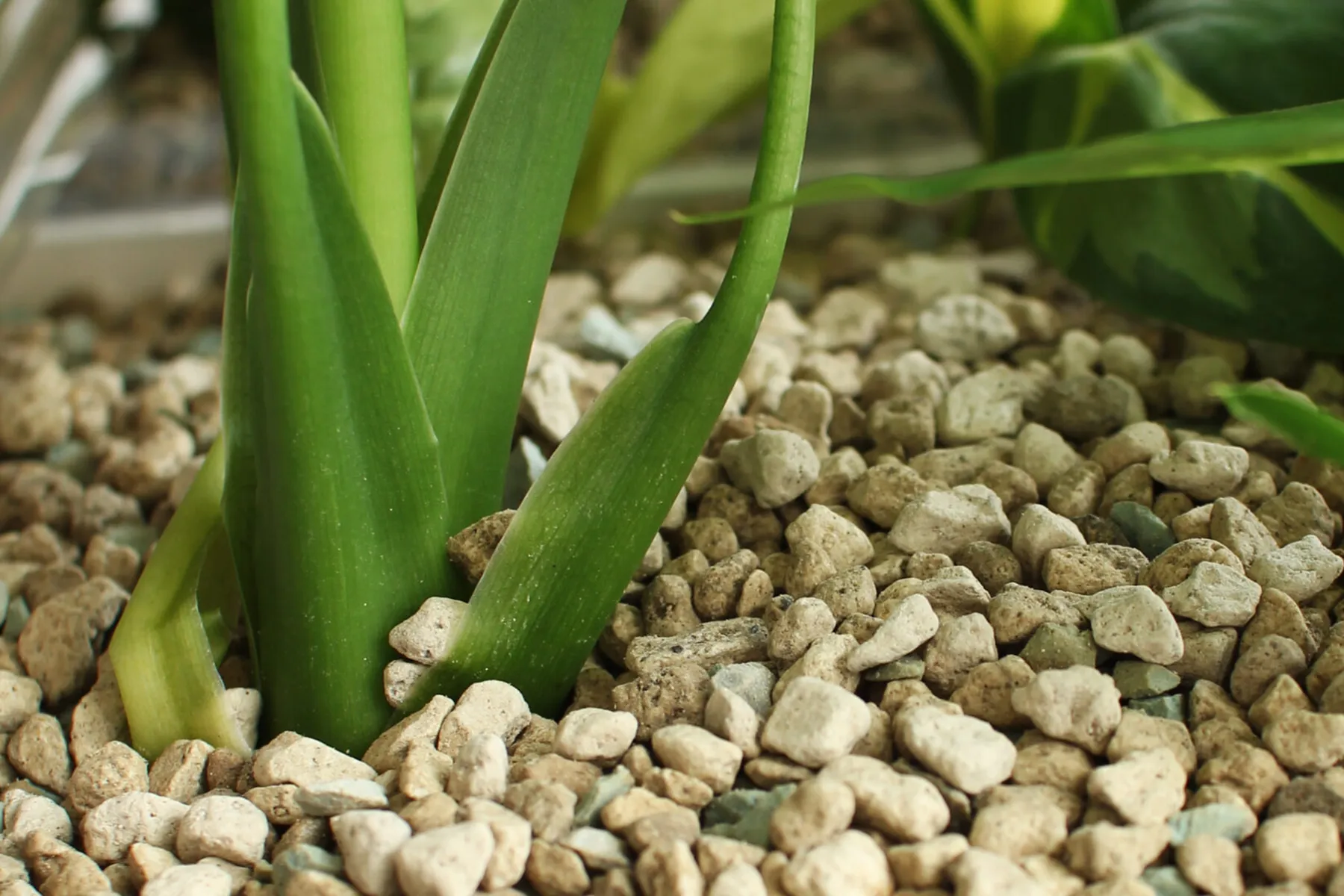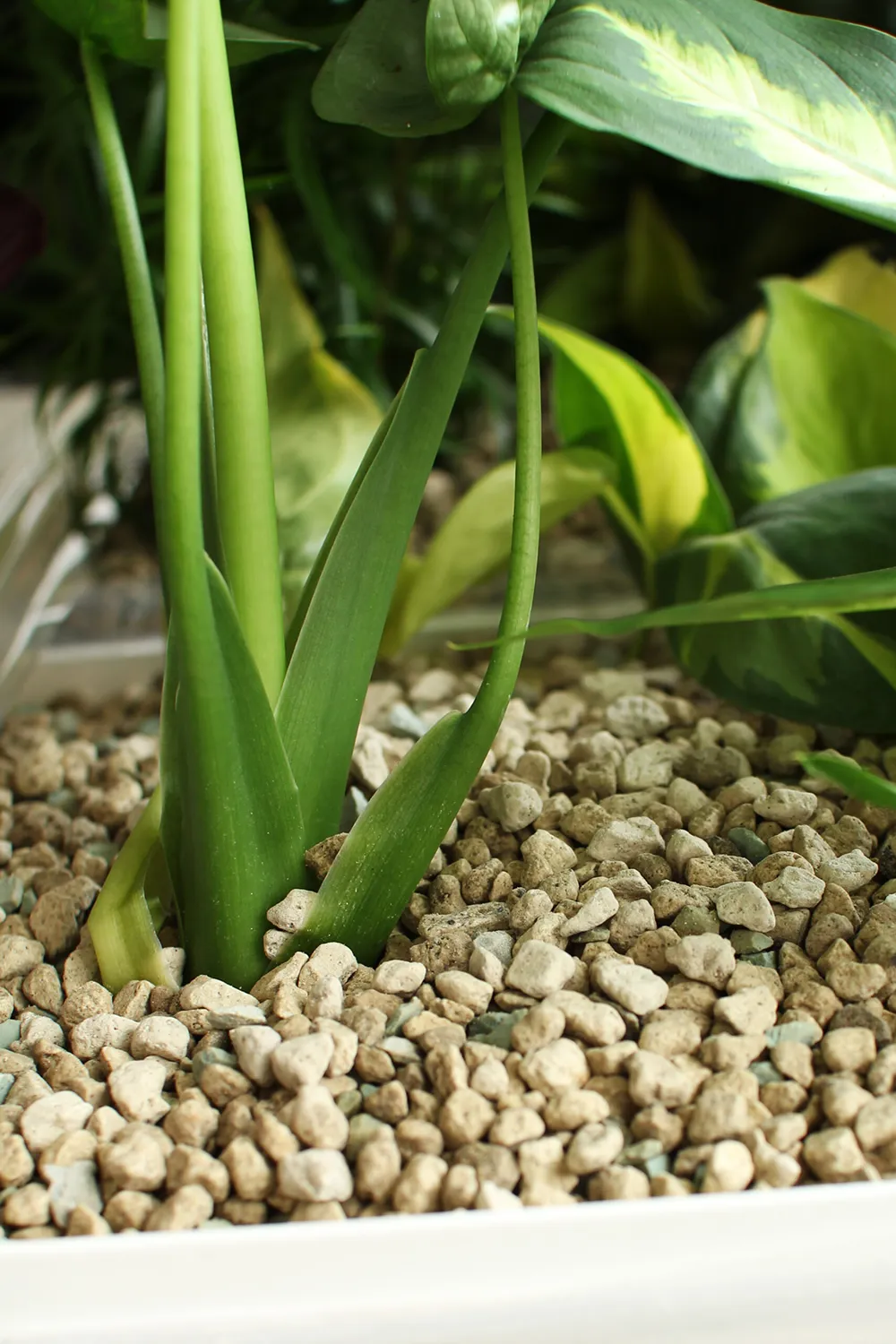
Biophilic design continues to influence how architects and businesses shape indoor environments. In 2026, designers are emphasizing systems that make indoor plant design more efficient, sustainable, and resilient. This evolution reflects a growing priority: connecting people to nature through smarter, longer-lasting plant systems.
Smarter plant designs through hydroculture
What exactly is hydroculture? Hydroculture is a method of growing plants without soil. Replacing soil with mineral materials delivers consistent oxygen and moisture to roots while reducing soil-borne pests. It also allows for precise nutrient control— an important advantage in commercial interiors when lighting, airflow, and plant positioning may be constantly changing.
In hydroculture, substrate choice (plant growth material) determines how the following factors perform:
- Air exchange (aeration) – how oxygen circulates through the spaces between particles
- Wickening, also called moisture movement – how efficiently water transfers from the reservoir to the roots
- Water retention – how evenly the substrate maintains hydration without oversaturation
- Root support and stability – how securely the plant anchors within its container or wall module
- Nutrient balance – how minerals are held, released, or flushed through the medium
- Longevity – how stable the material remains over time under regular irrigation

Hydroculture systems are now favored in offices, hotels, healthcare, and education projects because they stabilize plant health. As hydroculture becomes standard, plant experts are honing in on the quality and sustainability of substrates used.
Vulkaponic: mineral innovation for 2026
What is Vulkaponic? One material gaining attention is Vulkaponic, a mineral substrate derived from volcanic rock materials: pumice and zeolite. Its porous structure provides high air and water-holding capacity, giving roots the balance they need for stable growth. Because it’s lightweight and reusable, it supports both sustainability and long-term plant performance.
Vulkaponic’s neutral composition prevents nutrient buildup and soil compaction, which helps roots stay healthy over time. For large-scale installations, such as plant walls and patioscape planters, its stability and drainage system make it especially valuable. When speaking of Vulkaponic, “drainage” refers to internal drainage—the movement of water through and between the particles of the substrate. It’s about how water flows, disperses, and stabilizes within the growing medium, as opposed to runoff leaving the planter.
Plant Solutions is beginning to incorporate Vulkaponic into semi-hydroculture systems for interior landscaping projects. It represents the kind of sustainable innovation that aligns with our design philosophy: using proven materials that extend plant life and minimize waste.

Trending designers focus on longevity and resourcefulness
The defining trend of 2026 biophilic design is longevity. Clients are seeking plant systems that conserve resources and require less replacement.
Hydroculture and substrates like Vulkaponic enable longer intervals between maintenance cycles while maintaining plant vitality. Unlike traditional soil, mineral substrates don’t degrade or compact, so they retain a consistent structure for years. For business owners, this results in saving money on plant care maintenance and plant replacements.
Want to see these benefits in your building?
Plant Solutions specializes in designing hydroculture systems that reduce maintenance costs and align with your company’s sustainability goals. Speak with one of our design consultants today to see how we can build a long-lasting plant program for your space.
Architectural planting and sculptural greenery
Indoor plant design is taking on a bigger role in architectural planning. Plants are used to define sightlines, soften transitions, and add natural rhythm to structured interiors.
Mineral substrates like Vulkaponic make these designs easier to execute. Their clean appearance suits modern containers, and their stability supports complex compositions without compromising plant health.

How technology creates precision for plant health
Hydroculture integrates well with new sensor and irrigation technologies that are common in custom-built plant walls. Automated moisture tracking, nutrient-level monitoring, and low-volume irrigation reduce labor while improving consistency. These systems provide measurable data that design teams and horticultural technicians can use to maintain plant health efficiently.
Sustainability in material choice
Every element in biophilic design, from planters to substrates, affects environmental impact. Lightweight, reusable materials like Vulkaponic align with sustainability goals by reducing transport weight, extending system life, and lowering overall material waste.
This reflects Plant Solutions’ broader approach: integrating innovation with ecological responsibility across every form of plant design, from living walls and moss wall art to patioscapes and UV-artificials.

FAQs: hydroculture and biophilic design
What is hydroculture?
A growing system that replaces soil with mineral media such as pumice or clay pebbles. These alternative materials provide consistent moisture and oxygen while reducing maintenance and pests.
What is Semi-Hydroculture?
This is when a plant that is grown in a soil medium then replanted into Vulkaponic. The root ball still has soil around it but over time the roots develop and the plant eventually becomes fully Hydro.
What is Vulkaponic made of?
A blend of pumice and zeolite (derived from volcanic rock) that offers excellent aeration, drainage, and moisture regulation in semi-hydroculture systems.
Can existing planters be converted to hydrocultural systems?
Yes. Adding a water reservoir, level indicator, and mineral substrate converts most containers for efficient soilless growth.
How does hydroculture support sustainable biophilic design?
It allows precise watering and nutrient control, reduces soil waste, and supports plant longevity—key goals in modern sustainable interiors.
Which plants adapt best to hydroculture?
Tropical and hardy species such as dracaena, philodendron, pothos, sansevieria, and ZZ plants thrive in hydroculture-based systems.
Plant Solutions continues to explore materials like Vulkaponic to improve how living systems perform indoors. Plant design will always be about beautiful greenery that creates an impactful human experience. However, in 2026, biophilic design may focus less on aesthetics and more on modeling wellness and on practices that are as sustainable as possible.
Build Your 2026 Biophilic Design Today
Don’t let high maintenance and plant replacements hold your design back. The experts at Plant Solutions can help you leverage innovative systems like hydroculture and Vulkaponic to create a stunning, sustainable, and cost-effective indoor environment.
